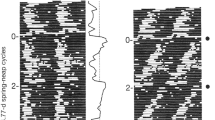Summary
It is well-established that human nocturnal melatonin secretion is suppressed by presentation of artificial light >2,000 lux, a level that is also therapeutically effective in alleviating winter depression symptoms of Seasonal Affective Disorder [SAD]. Furthermore, early-morning bright light induces phase advances of the melatonin cycle in SAD patients (Lewy et al., 1987 a). The functional significance of melatonin in SAD remains unclear. With plasma melatonin sampled at 20-min intervals in a series of overnight studies, we found marked phase delays of the cycle, relative to that previously reported for normals, in 4/5 depressed SAD patients. 2,500 lux light exposure at 6–8a.m. resulted in exponentially declining melatonin levels that approached low daytime baselines within two hours (t1/2 = 45.52 min). All five patients showed clinical remissions as well as phase advances of the melatonin cycle of 0.75 to 3.27 hours (mean, 1.94± 0.84hours) after one week of daily exposure from 6–8a.m. and p.m. These results suggest that the combination of early morning and early evening light exposures induces circadian phase adjustments similar to those of morning light alone, by impacting a photosensitive interval when, in SAD, melatonin secretion overshoots its normal nocturnal phase.
Similar content being viewed by others
References
Beck-Friis J, von Rosen D, Kjellman BF, Ljunggren J-G, Wetterberg L (1984) Melatonin in relation to body measures, sex, age, season and the use of drugs in patients with major affective disorders and healthy subjects. Psychoneuroendocinrology 9: 261–277
Broadway JW, Arendt J (1985) 24-hour rhythms of human 6-hydroxymelatonin sulfate (aMT6s) in Antarctica. J Endocrinol 107: Abstract 96
Grof E, Grof P, Brown GM, Arato M, Lane J (1985) Investigations of melatonin secretion in man. Prog Neuropsychopharmacol Biol Psychiatry 9: 609–612
Hamilton M (1967) Development of a rating scale for primary depressive illness. Br J Soc Clin Psychol 6: 278–296
Hamilton M (1982) The effect of treatment on the melancholias. Br J Psychiatry 140: 223–230
Hellekson CJ (1987) Phenomenology of Seasonal Affective Disorder. Paper presented at NIMH Workshop on Seasonal Affective Disorder, Bethesda, Maryland
Honma K, Honma S, Wada T (1987) Phase dependent phase shift of free-running human circadian rhythms in response to a single bright light pulse. Experientia 43: 1205–1207
Illnerová H, Vaněček J (1985) Complex control of the circadian rhythm in pineal melatonin production. In: Mess B, Rúzás C, Tima L, Pévet P (eds) The pineal gland: current state of pineal research. Elsevier, Amsterdam, pp 137–153
Isaacs G, Stainer S, Moor S, Sensky T, Thompson C (1986) Is photoperiod extension necessary, in phototherapy? Paper presented at Conf Recent Advances in Depression. Basle, Switzerland
Jacobsen FM, Wehr TA, Skwerer R, Sack DA, Rosenthal NE (1987) Morning versus midday phototherapy of Seasonal Affective Disorder. Am J Psychiatry 144: 1301–1305
Lewy AJ, Wehr TA, Goodwin FK, Newsome DA, Markey SP (1980) Light suppresses melatonin secretion in humans. Science 210: 1267–1269
Lewy AJ, Wehr TA, Goodwin FK, Newsome DA, Rosenthal NE (1981) Manicdepressive patients may be supersensitive to light. Lancet 1: 383–384
Lewy AJ, Kern HE, Rosenthal NE, Wehr TA (1982) Bright artificial light treatment of a manic-depressive patient with a seasonal mood cycle. Am J Psychiatry 139: 1496–1498
Lewy AJ, Sack RL, Singer CM (1985) Immediate and delayed effects of bright light on human melatonin production: shifting “dawn” and “dusk” shifts the dim light melatonin onset (DLMO). Ann NY Acad Sci 453: 253–259
Lewy AJ, Sack RL (1986) Light therapy and psychiatry. Proc Soc Exp Biol Med 183: 11–18
Lewy AJ, Sack RL, Miller S, Hoban TM (1987a) Antidepressant and circadian phase-shifting effects of light. Science 235: 352–354
Lewy AJ, Sack RL, Singer CM, White DM, Hoban TM (1987b) Winter depression and the phase shift hypothesis for bright light's therapeutic effects: history, theory and experimental evidence. Paper presented at NIMH Workshop on Seasonal Affective Disorder. Bethesda, Maryland
Pittendrigh CS, Daan S (1976) A functional analysis of circadian pacemakers in nocturnal rodents: IV. Entrainment: pacemaker as clock. J Comp Physiol 106: 291–331
Reiter RJ (1985) Action spectra, dose-response relationships, and temporal aspects of light's effects on the pineal gland. Ann NY Acad Sci 453: 215–230
Rosenthal NE, Sack DA, Gillin JC, Lewy AJ, Goodwin FK, Davenport Y, Mueller PS, Newsome DA, Wehr TA (1984) Seasonal affective disorder: a description of the syndrome and preliminary findings with light therapy. Arch Gen Psychiatry 41: 72–80
Rosenthal NE, Sack DA, Jacobsen FM, James SP, Parry BL, Arendt J, Tamarkin L, Wehr TA (1986) Melatonin in Seasonal Affective Disorder and phototherapy. J Neural Transm [Suppl] 21: 257–268
Rosenthal NE, Skwerer RG, Sack DA, Duncan CC, Jacobsen FM, Tamarkin L, Wehr TA (1987) Biological effects of morning-plus-evening bright light treatment of seasonal affective disorder. Psychopharmacol Bull 23: 364–369
Spitzer RL, Endicott J, Robbins E (1978) Research diagnostic criteria: rationale and reliability. Arch Gen Psych 35: 773–782
Stewart JW (1987) Importance of timing and duration of phototherapy. Arch Gen Psychiatry 44: 921
Terman M (1988) On the question of mechanism in phototherapy for seasonal affective disorder: considerations of clinical efficacy and epidemiology. J Biol Rhythms (in press)
Terman M, Quitkin FM, Terman JS, Stewart JW, McGrath PJ (1987) The timing of phototherapy: effects on clinical response and the melatonin cycle. Psychopharmacol Bull 23: 354–357
Tukey JW (1977) Exploratory data analysis. Addison-Wesley, Reading, Massachusetts
Waldhauser F, Waldhauser M, Lieberman HR, Deng M-H, Lynch HJ, Wurtman RJ (1984) Bioavailability of oral melatonin in humans. Neuroendocrinology 39: 307–313
Wehr TA, Jacobsen FM, Sack DA, Arendt J, Tamarkin L, Rosenthal NE (1986) Photo-therapy of seasonal affective disorder. Arch Gen Psychiatry 43: 870–875
Wirz-Justice A, Schmid AC, Graw P, Krauechi K, Kielholz P, Poeldinger W, Fisch HU, Buddebero C (1987) Dose relationships of morning bright white light in Seasonal Affective Disorders. Experientia 43: 547–576
Author information
Authors and Affiliations
Rights and permissions
About this article
Cite this article
Terman, M., Terman, J.S., Quitkin, F.M. et al. Response of the melatonin cycle to phototherapy for Seasonal Affective Disorder. J. Neural Transmission 72, 147–165 (1988). https://doi.org/10.1007/BF01250238
Received:
Accepted:
Issue Date:
DOI: https://doi.org/10.1007/BF01250238



